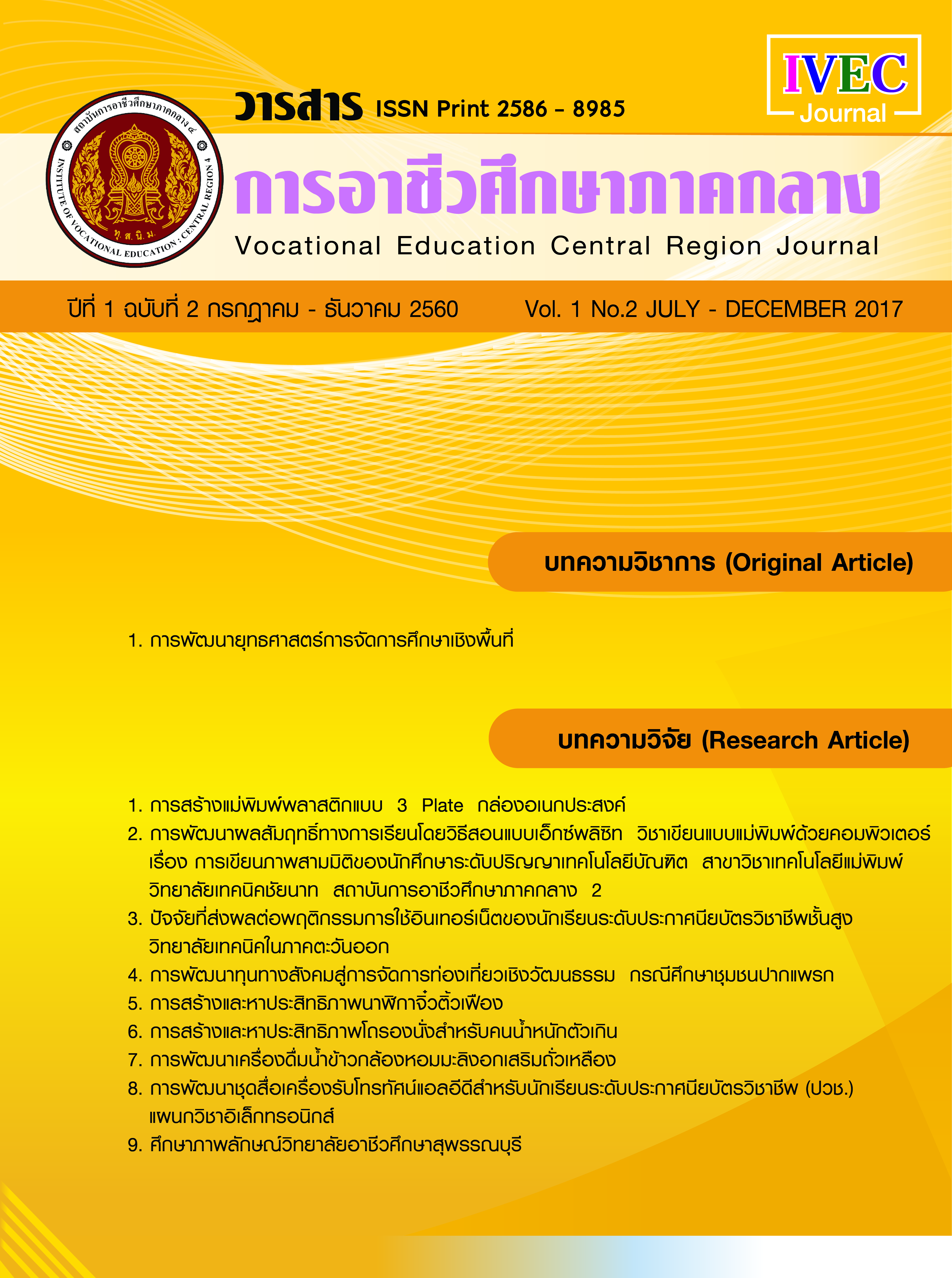The Development of Germinated Brown Rice Milk Fortified with Soybean
Main Article Content
Abstract
The objectives of this research were to: 1) study the sensory acceptability of different amounts of Germinated Brown Thai Hom Mali Rice with Soybean beverage and 2) study color values and nutrition of Germinated Brown Thai Hom Mali Rice with Soybean with different levels.
The results of this research were as follows : 1) the 10% of Germinated Brown Thai Hom Mali Rice with Soybean beverage was at the highest overall liking (p<0.05) 2) the 15% of Germinated Brown Thai Hom Mali Rice with soybean in L* decreased (p<0.05) but a* and b* increased because of addition soybean that made yellow color 3) The nutritional of the Germinated Brown Thai Hom Mali Rice with soybean 0%, 5%, 10%, and 15% in the 240 grams amount gave energy 143.65, 152.25, 160.85 and 169.45 kcal. Respectively and 4) the addition of soybeans also increased nutrition.
Article Details
|
บทความ ข้อมูล เนื้อหา รูปภาพ ฯลฯ ที่ได้รับการตีพิมพ์ในวารสาร การอาชีวศึกษาภาคกลาง ถือเป็นลิขสิทธิ์ของวารสารการอาชีวศึกษาภาคกลางหากบุคคลหรือหน่วยงานใดต้องการนำทั้งหมดหรือส่วนใดส่วนหนึ่ง ไปเผยแพร่ต่อหรือเพื่อกระทำการใด ๆ กองบรรณาธิการไม่สงวนสิทธิ์ ในการคัดลอกบทความเพื่อการศึกษาแต่ให้อ้างอิงแหล่งที่มาให้ครบถ้วน สมบูรณ์ สงวนสิทธิ์ โดย สถาบันการอาชีวศึกษาภาคกลาง 4 ที่ตั้ง 90 ถนนเทศา ตำบลพระปฐมเจดีย์ อำเภอเมือง จังหวัดนครปฐม โทรศัพท์ 034 242 856 , โทรสาร 034 242 858 ISSN : 3056-9176 (print) ISSN : 2985-2382 (online) |
References
กระทรวงสาธารณะสุข กรมอนามัย กองโภชนาการ. (2544). ตารางแสดงคุณค่าทางโภชนาการของอาหารไทย.กรุงเทพฯ: โรงพิมพ์องค์การทหารผ่านศึก.
กาญจนา บุญนาที. (2551). พฤติกรรมการบริโภคเครื่องดื่มเพื่อสุขภาพประเภท Functional Drink ของสตรีวัยทำงานในกรุงเทพมหานคร. วิทยานิพนธ์มหาบัณฑิต สาขาการตลาดคณะบริหารธุรกิจ มหาวิทยาลัยเทคโนโลยีราชมงคลธัญบุรี.
สุนันทา วงศ์ปิยชน, กฤษณา สุดทะสาร และวัชรี สุขวิวัฒน์. (2554). ข้าวกล้องงอกและผลิตภัณฑ์เครื่องดื่มข้าวกล้องงอก. การประชุมวิชาการข้าว เนื่องในโอกาสวันข้าวและชาวนาแห่งชาติ ครั้งที่ 2 ปี 2554 ณ โรงแรมอมารี แอร์พอร์ต ดอนเมือง กรุงเทพฯ. 3-4 มิถุนายน 2554. หน้า 133-146.
Canadian Food Inspection Agency. (1996). The Biology of Glycine max (L.) Merr. (Soybean): Biology Document BIO. Ontario: Plant Biosafety Office.
Chamber IV, E. and M.B.wolf. (1996). Sensory tesing methods. 2nd ed. Philadelphia USA: American Society for Tesing and Materials.
Iwuoha, C.I. and Umunnakwe, K.E. (1997). Chemical, physical and sensory characteristics of soymilk as affected by processing method, temperature and duration of storage. J. Food Chem. 59(3): 313-379.
Leszkowiat, M.J., Yada, R,Y., Coffin, R.H. and Stanley, D.W. (1990) . Starch gelatinsation in cold temperature sweetening resistant potatoes. J. Food Science. 55(5): 1338-1340.
Tian S., Nakamura K. and KayaharaH. (2004). Analysis of phenolic compounds in white rice, brown rice, And germinated brown rice. J. Food Chem. 52(15): 4808-4813.
Poysa, V. and Woodrow, L. (2002). Stability of soybean seed composition and its effect on soymilk and tofu yield and quality. J. Food Research international. 35(4): 337-345.
Wilkens, W.F., L.R. and Hand, D.B. (1967). Effect of processing method on oxidative off flavour of soybean milk. J. Food Technology. 21(12): 1630-1633.

